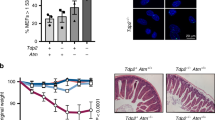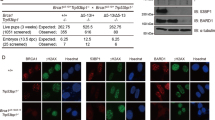Abstract
V(D)J recombination is essential for the maturation of lymphocytes. Because of the involvement of cutting and joining DNA double strands, this recombination activity is strictly contained within the noncycling phases of the cell cycle. Such containment is crucial for the maintenance of genomic integrity. The ataxia telangiectasia mutated (ATM) gene is known to have a central role in sensing general DNA damage and mediating cell-cycle checkpoint. In this study, we investigated the role of ATM and its downstream targets in the cell-cycle control of V(D)J recombination in vivo. Our results revealed the persistence of double-strand breaks (DSBs) throughout the cell cycle in ATM−/− and p53−/− thymocytes, but the cell-cycle regulation of a V(D)J recombinase, Rag-2, was normal. The histone variant H2AX, which is phosphorylated during normal V(D)J recombination, was dispensable for containing DSBs. H2AX was still phosphorylated at V(D)J loci in the absence of ATM. Therefore, V(D)J recombination, a physiological DNA rearrangement process, activates the ATM/p53 pathway to contain DNA breaks within the noncycling cells and surprisingly this pathway is not important for containing Rag-2 activity. This study shows the dynamic multiple functions of ATM in maintaining genomic stability and preventing tumorigenesis in developing lymphocytes.
This is a preview of subscription content, access via your institution
Access options
Subscribe to this journal
Receive 50 print issues and online access
$259.00 per year
only $5.18 per issue
Buy this article
- Purchase on Springer Link
- Instant access to full article PDF
Prices may be subject to local taxes which are calculated during checkout



Similar content being viewed by others
References
Bakkenist CJ, Kastan MB . (2003). DNA damage activates ATM through intermolecular autophosphorylation and dimer dissociation. Nature 421: 499–506.
Barlow C, Hirotsune S, Paylor R, Liyanage M, Eckhaus M, Collins F et al. (1996). Atm-deficient mice: a paradigm of ataxia telangiectasia. Cell 86: 159–171.
Bassing CH, Chua KF, Sekiguchi J, Suh H, Whitlow SR, Fleming JC et al. (2002). Increased ionizing radiation sensitivity and genomic instability in the absence of histone H2AX. Proc Natl Acad Sci USA 99: 8173–8178.
Bassing CH, Ranganath S, Murphy M, Savic V, Gleason M, Alt FW . (2008). Aberrant V(D)J recombination is not required for rapid development of H2ax/p53-deficient thymic lymphomas with clonal translocations. Blood 111: 2163–2169.
Bassing CH, Suh H, Ferguson DO, Chua KF, Manis J, Eckersdorff M et al. (2003). Histone H2AX: a dosage-dependent suppressor of oncogenic translocations and tumors. Cell 114: 359–370.
Borghesani PR, Alt FW, Bottaro A, Davidson L, Aksoy S, Rathbun GA et al. (2000). Abnormal development of Purkinje cells and lymphocytes in Atm mutant mice. Proc Natl Acad Sci USA 97: 3336–3341.
Bredemeyer AL, Huang CY, Walker LM, Bassing CH, Sleckman BP . (2008). Aberrant V(D)J recombination in ataxia telangiectasia mutated-deficient lymphocytes is dependent on nonhomologous DNA end joining. J Immunol 181: 2620–2625.
Bredemeyer AL, Sharma GG, Huang CY, Helmink BA, Walker LM, Khor KC et al. (2006). ATM stabilizes DNA double-strand-break complexes during V(D)J recombination. Nature 442: 466–470.
Callen E, Jankovic M, Difilippantonio S, Daniel JA, Chen HT, Celeste A et al. (2007). ATM prevents the persistence and propagation of chromosome breaks in lymphocytes. Cell 130: 63–75.
Celeste A, Petersen S, Romanienko PJ, Fernandez-Capetillo O, Chen HT, Sedelnikova OA et al. (2002). Genomic instability in mice lacking histone H2AX. Science 296: 922–927.
Chen HT, Bhandoola A, Difilippantonio MJ, Zhu J, Brown MJ, Tai X et al. (2000). Response to RAG-mediated VDJ cleavage by NBS1 and gamma-H2AX. Science 290: 1962–1965.
Desiderio S, Lin WC, Li Z . (1996). The cell cycle and V(D)J recombination. Curr Top Microbiol Immunol 217: 45–59.
Donehower LA, Harvey M, Slagle BL, McArthur MJ, Montgomery Jr CA, Butel JS et al. (1992). Mice deficient for p53 are developmentally normal but susceptible to spontaneous tumours. Nature 356: 215–221.
Franco S, Gostissa M, Zha S, Lombard DB, Murphy MM, Zarrin AA et al. (2006). H2AX prevents DNA breaks from progressing to chromosome breaks and translocations. Mol Cell 21: 201–214.
Gao Y, Chaudhuri J, Zhu C, Davidson L, Weaver DT, Alt FW . (1998). A targeted DNA-PKcs-null mutation reveals DNA-PK-independent functions for KU in V(D)J recombination. Immunity 9: 367–376.
Guidos CJ, Williams CJ, Grandal I, Knowles G, Huang MT, Danska JS . (1996). V(D)J recombination activates a p53-dependent DNA damage checkpoint in scid lymphocyte precursors. Genes Dev 10: 2038–2054.
Huang CY, Sharma GG, Walker LM, Bassing CH, Pandita TK, Sleckman BP . (2007). Defects in coding joint formation in vivo in developing ATM-deficient B and T lymphocytes. J Exp Med 204: 1371–1381.
Jankovic M, Nussenzweig A, Nussenzweig MC . (2007). Antigen receptor diversification and chromosome translocations. Nat Immunol 8: 801–808.
Jiang H, Chang FC, Ross AE, Lee J, Nakayama K, Desiderio S . (2005). Ubiquitylation of RAG-2 by Skp2-SCF links destruction of the V(D)J recombinase to the cell cycle. Mol Cell 18: 699–709.
Lavin MF . (2008). Ataxia-telangiectasia: from a rare disorder to a paradigm for cell signalling and cancer. Nat Rev Mol Cell Biol 9: 759–769.
Lee GS, Neiditch MB, Salus SS, Roth DB . (2004). RAG proteins shepherd double-strand breaks to a specific pathway, suppressing error-prone repair, but RAG nicking initiates homologous recombination. Cell 117: 171–184.
Lee JH, Paull TT . (2005). ATM activation by DNA double-strand breaks through the Mre11-Rad50-Nbs1 complex. Science 308: 551–554.
Liao MJ, Zhang XX, Hill R, Gao J, Qumsiyeh MB, Nichols W et al. (1998). No requirement for V(D)J recombination in p53-deficient thymic lymphoma. Mol Cell Biol 18: 3495–3501.
Livak KJ, Schmittgen TD . (2001). Analysis of relative gene expression data using real-time quantitative PCR and the 2(-Delta Delta C(T)) Method. Methods 25: 402–408.
Liyanage M, Weaver Z, Barlow C, Coleman A, Pankratz DG, Anderson S et al. (2000). Abnormal rearrangement within the alpha/delta T-cell receptor locus in lymphomas from Atm-deficient mice. Blood 96: 1940–1946.
McBlane JF, van Gent DC, Ramsden DA, Romeo C, Cuomo CA, Gellert M et al. (1995). Cleavage at a V(D)J recombination signal requires only RAG1 and RAG2 proteins and occurs in two steps. Cell 83: 387–395.
Monroe RJ, Seidl KJ, Gaertner F, Han S, Chen F, Sekiguchi J et al. (1999). RAG2:GFP knockin mice reveal novel aspects of RAG2 expression in primary and peripheral lymphoid tissues. Immunity 11: 201–212.
Oettinger MA, Schatz DG, Gorka C, Baltimore D . (1990). RAG-1 and RAG-2, adjacent genes that synergistically activate V(D)J recombination. Science 248: 1517–1523.
Perkins EJ, Nair A, Cowley DO, Van Dyke T, Chang Y, Ramsden DA . (2002). Sensing of intermediates in V(D)J recombination by ATM. Genes Dev 16: 159–164.
Robbiani DF, Bothmer A, Callen E, Reina-San-Martin B, Dorsett Y, Difilippantonio S et al. (2008). AID is required for the chromosomal breaks in c-myc that lead to c-myc/IgH translocations. Cell 135: 1028–1038.
Rogakou EP, Pilch DR, Orr AH, Ivanova VS, Bonner WM . (1998). DNA double-stranded breaks induce histone H2AX phosphorylation on serine 139. J Biol Chem 273: 5858–5868.
Savic V, Yin B, Maas NL, Bredemeyer AL, Carpenter AC, Helmink BA et al. (2009). Formation of dynamic gamma-H2AX domains along broken DNA strands is distinctly regulated by ATM and MDC1 and dependent upon H2AX densities in chromatin. Mol Cell 34: 298–310.
Schatz DG, Oettinger MA, Baltimore D . (1989). The V(D)J recombination activating gene, RAG-1. Cell 59: 1035–1048.
Schlissel M, Constantinescu A, Morrow T, Baxter M, Peng A . (1993). Double-strand signal sequence breaks in V(D)J recombination are blunt, 5′-phosphorylated, RAG-dependent, and cell cycle regulated. Genes Dev 7: 2520–2532.
Spilianakis CG, Lalioti MD, Town T, Lee GR, Flavell RA . (2005). Interchromosomal associations between alternatively expressed loci. Nature 435: 637–645.
Stiff T, O’Driscoll M, Rief N, Iwabuchi K, Lobrich M, Jeggo PA . (2004). ATM and DNA-PK function redundantly to phosphorylate H2AX after exposure to ionizing radiation. Cancer Res 64: 2390–2396.
Tsai AG, Lu H, Raghavan SC, Muschen M, Hsieh CL, Lieber MR . (2008). Human chromosomal translocations at CpG sites and a theoretical basis for their lineage and stage specificity. Cell 135: 1130–1142.
Vacchio MS, Olaru A, Livak F, Hodes RJ . (2007). ATM deficiency impairs thymocyte maturation because of defective resolution of T cell receptor alpha locus coding end breaks. Proc Natl Acad Sci USA 104: 6323–6328.
Widrow RJ, Rabinovitch PS, Cho K, Laird CD . (1997). Separation of cells at different times within G2 and mitosis by cyclin B1 flow cytometry. Cytometry 27: 250–254.
Winrow CJ, Pankratz DG, Vibat CR, Bowen TJ, Callahan MA, Warren AJ et al. (2005). Aberrant recombination involving the granzyme locus occurs in Atm−/− T-cell lymphomas. Hum Mol Genet 14: 2671–2684.
Yan M, Zhu C, Liu N, Jiang Y, Scofield VL, Riggs PK et al. (2006). ATM controls c-Myc and DNA synthesis during postnatal thymocyte development through regulation of redox state. Free Radic Biol Med 41: 640–648.
Zhu C, Roth DB . (1995). Characterization of coding ends in thymocytes of scid mice: implications for the mechanism of V(D)J recombination. Immunity 2: 101–112.
Acknowledgements
We acknowledge MD Anderson Flow Cytometry Core Facility for cell sorting and the Immune Imaging Core Facility for their assistance with confocal microscopy. This study was financially supported in part by NIH Grant CA116933, the Leukemia Research Foundation, the American Cancer Society–Bonnie Kies Lymphatic System Research Scholar grant (CZ) and NIH Grant T32 CA009598-17 (MED).
Author information
Authors and Affiliations
Corresponding author
Additional information
Supplementary Information accompanies the paper on the Oncogene website (http://www.nature.com/onc)
Supplementary information
Rights and permissions
About this article
Cite this article
Dujka, M., Puebla-Osorio, N., Tavana, O. et al. ATM and p53 are essential in the cell-cycle containment of DNA breaks during V(D)J recombination in vivo. Oncogene 29, 957–965 (2010). https://doi.org/10.1038/onc.2009.394
Received:
Revised:
Accepted:
Published:
Issue Date:
DOI: https://doi.org/10.1038/onc.2009.394



